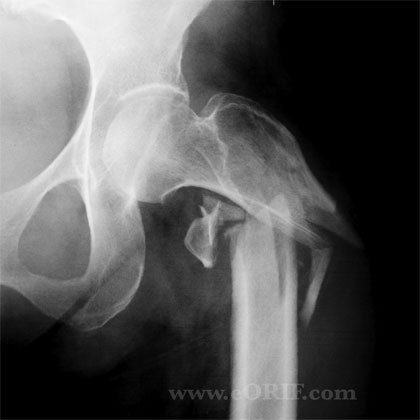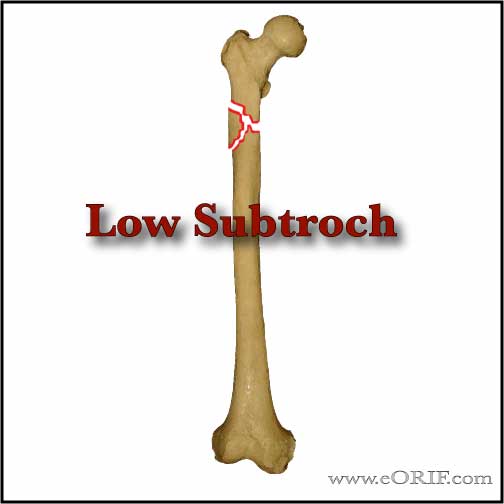|



|
synonyms: subtroch femur fracture.
Subtrochanteric Femur Fracture ICD-10
Subtrochanteric Femur Fracture ICD-9
- 820.22(closed)
- 820.32 (open)
Subtrochanteric Femur Fracture Etiology / Epidemiology / Natural History
- Subtrochanteric fractures = femurs fractures occuring below the lesser trochanter to 5cm distally in the femoral shaft.
- Occurs from high-energy injury in young patients and low-energy falls in osteoporotic elderly patients.
- Atypical subtrochanteric femur fractures have been increasingly reported in patients on bisphosphonates. These have been reported with little or no trauma.
Subtrochanteric Femur Fracture Anatomy
- Proximal fragment is typically externally rotated and flexed due to the pull of the iliopsoas (Iliacus/ Psoas) and abducted by the short abductors inserting into the greater trochanter.
- Distal fragment is displaced medially by the adductor magnus.
Subtrochanteric Femur Fracture Clinical Evaluation
- ATLS resuscitation. These can be high enegery injuries, assessment should begin with the A,B,C's.
- Leg is typically shortened and externally rotated.
- Document neurovascular exam.
Subtrochanteric Femur Fracture Xray
- A/P pelvis, A/P and lateral of affected hip and femur.
Subtrochanteric Femur Fracture Classification / Treatment
- Low subtrochanteric fracture (below lesser trochanter with piriformis fossa intact)
-Treatment = standard locked IM nail
- High subtrochanteric fracture (fractures with extention above the lesser trochanter)
-Treatment = locked cephalomedullary nail. Beware of varus malreduction. The primary reason for this is failing to counteract the muscle forces acting on the proximal fragment combined with the adducted position of the distal femur during portal creation. Ensure anatomic reduction before guide wire and nail insertion. A clamp placed on the proximal fragment can be used to control proximal fragment movement and prevent eccentric reaming. In addition, excessive adduction of the distal fragment during reaming and nail placement should be avoided. (French BG, Tornetta P III: Clin Orthop 1998;348:95-100).
- AFFs = atypical subtrochanteric femur fractures. Low-energy fractures mainly in elderly femurs on prolonged bisphosphonate therapy. Generally has medial spike with a short-oblique fracture pattern and lateral cortical thickening. Treatment = antegrade reamed interlocking nail. Discontinue bisphosphonate therapy, Supplement with calciam and vitamin D, consider recombinant parathyroid hormone (teriparatide). Evaluate contralateral femur (AFFs is often bilateral. If patient on long term bisophosphonate therapy has pain with normal xray consider MRI for insufficency fracture. Fractures take twice as long to heal (7 months). (Egol KA, OTA 2016 annual meeting).
- AO Classification AO Classification
- Elderly pts with fragility fractures should be evaluated for osteoporosis.
Subtrochanteric Femur Fracture Associated Injuries / Differential Diagnosis
Subtrochanteric Femur Fracture Complications
Subtrochanteric Femur Fracture Follow-up Care
- Post-op: WBAT if anatomic reduction and posteromedial bony contact achieved at surgery, otherwise NWB. Elderly pts with fragility fractures should be evaluated for osteoporosis.
- 7-10 Days: Wound check
- 6 Weeks: Review xrays, advance weight bearing status when callus is evident on xrays.
- 3 Months: Review xrays, consider nail dynamization if fracture union is not evident.
- 6 Months: Assess status, review xrays, return to full duty if applicable.
- 1Yr: Review xrays, assess outcomes.
Subtrochanteric Femur Fracture References
|



